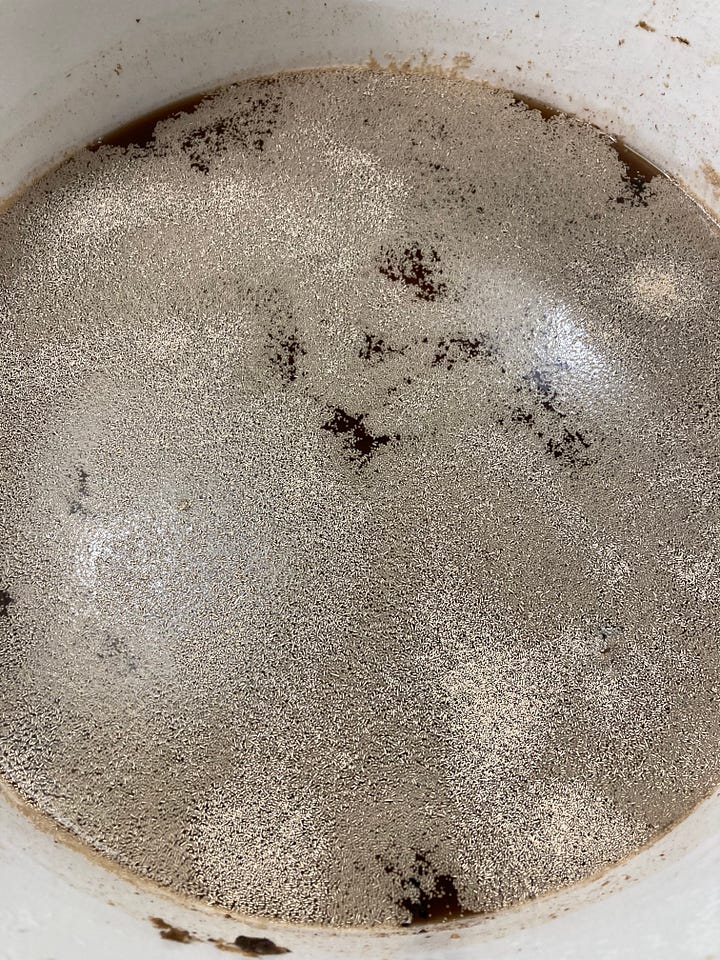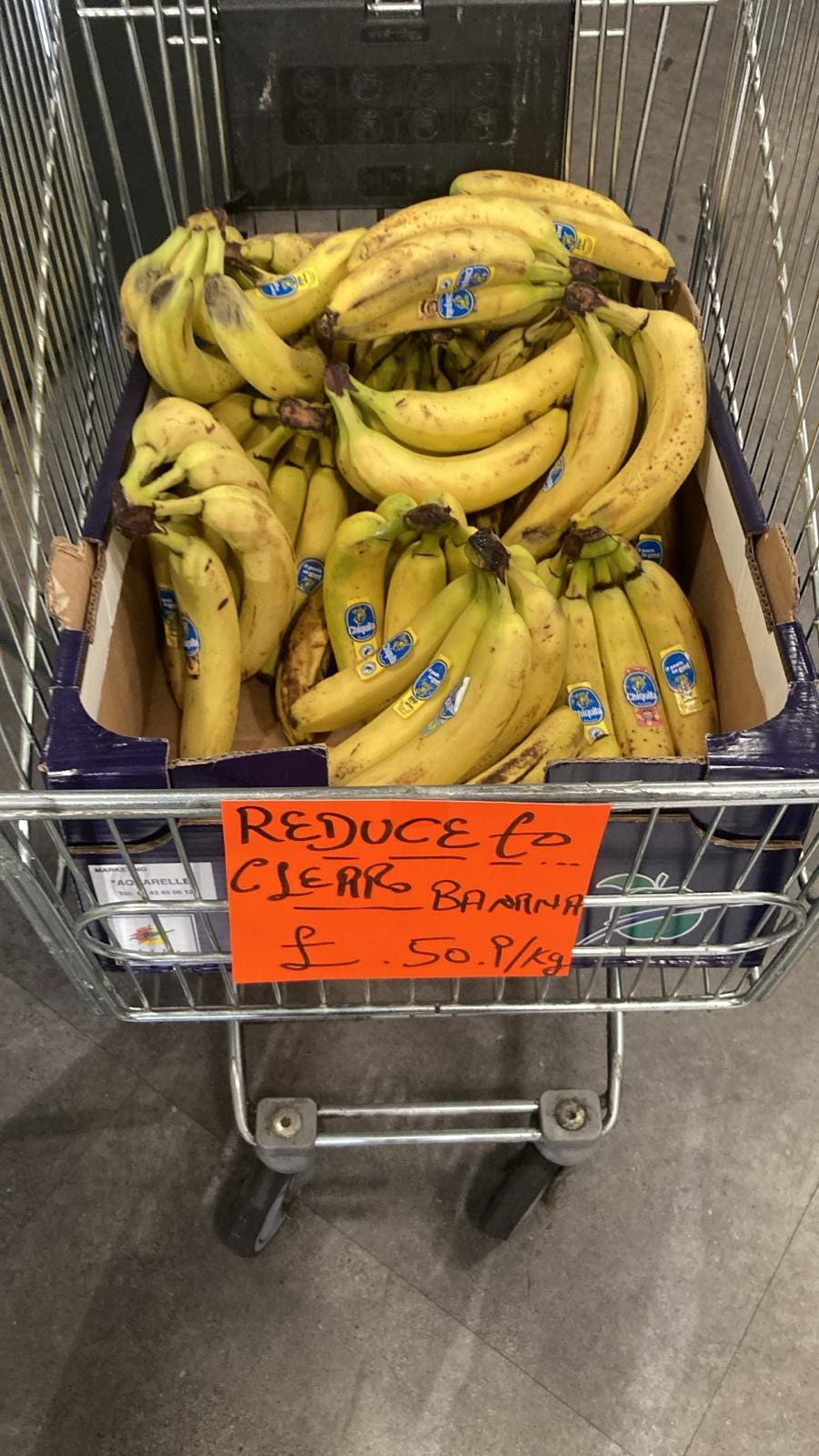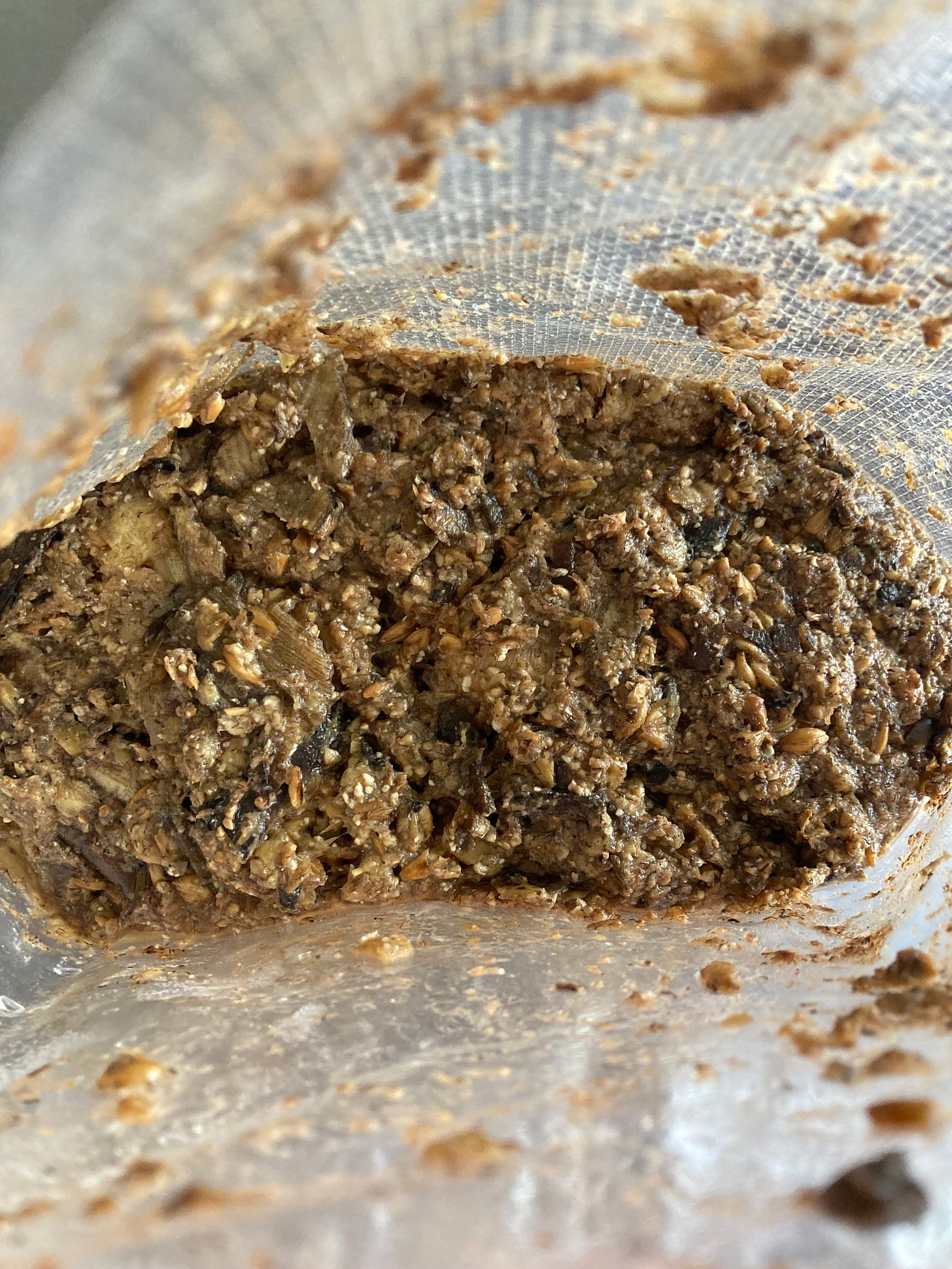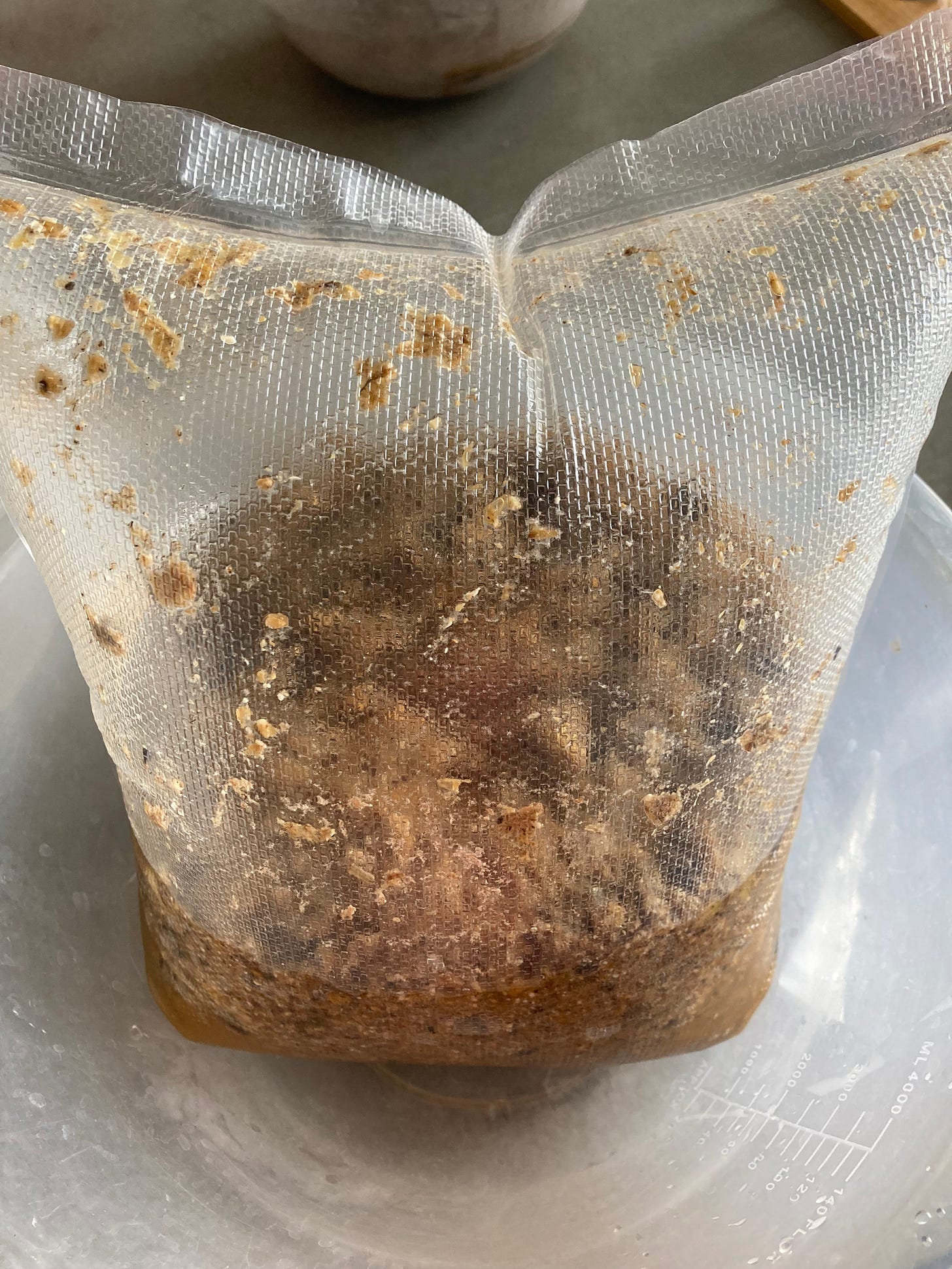One day i realised that i had only a very little left on the bottom of the banana shochu bottle. Only a few drops were washing the leftover banana crisps (quite soggy by that moment) and toasted pecan woodchips. So i started the manifestation process.
footnote: when i created this banana peel rum for the first time i knew all the mistakes i made. So like every perfectionist’ i wanted to make something better.
I didn’t need to wait long, first i found a couple of kilos of organic bananas at my neighbour's supermarket. Maybe a few days later, my best friend Henry found a whole trolley worth of ‘reduce to clear’ bananas in our asian supermarket. He grabbed as much as he could, then i went back and also did my part. Of course, the original plan was to only find enough (~5000g) for the same banana shochu experiment - instead we managed to gather like 15kg for hardly any money.
footnote: it’s a sad truth how little value we add to such wonderful products as bananas - how little we know about it and how we take it for granted having them. Not green, not spotted, not too dark or too soft or too hard - but just that fucking perfect state (the banana stays in no longer than 2 days at room temperature). This does make me angry and i would love to force people to read more information about banana skins and their health benefits with its nutritional information.
So now i had waaaaaaaaaaaaaaaay too many bananas ripening and blackening in my flat. I ve decided i use this possibility to launch a ‘hand in hand’ experiment next to each other - one running by koji rice (banana sake - shochu) and the other one running by malted barley (banana beer - whiskey). Because why not?
:))))))))))))))))))))))))))))))))))))))))))))))))))))))))))))))))
KOJI conversion.


I slightly modified the recipe i used before - when i was making an amazake with the banana peels and koji rice i was using pretty low hydration, simply because i had very little space. I could only imagine doing my amazake in jars sitting in my big plastic bucket with my sous vide stick in there keeping the temperature at 64 for 12-14 hours. And i could only fit very limited amount of mash into those jars. Again im learning continuously, lower hydration can lower the success of full sugar conversion. So i increased the water content and changed nothing else in the recipe.
Instead of jars i used vacuum bags so no need for continuous stirring and i reached the preferable temperature quite fast. I also did a protein rest at 40 degrees to see if we can open up some interesting umami flavours.
After the conversion, i added liquid malt and molasses, left all on the lees and using a specific sake yeast, i pitched the banazake and let it go wild.
MALTED BARLEY conversion.
Obviously something had to go wrong. As full control is only an illusion. But lets not jump too fast too far.
So i adjusted the recipe a bit (having a bit more freedom with the hydration) and made a very very silly mistake. Honestly i dont know what i was thinking, must have had a big BRAINFART. But i share so hope you won’t make the same mistake.
I was quite lacking of time in the last couple of days, so i thought i can save an hour or two if i prepare the malted barley banana mash in bags before i go for a dinner so the next thing in the morning i can just jump the bags into the waterbath and do the protein rest and the conversion run. HAHAHAHAHAHAHAHAHAHAHAHAHAHAHAHAHAHAHAHAHAHAHAHAHAHAHAHAHAHAHAHA
OF COURSE THAT THE NICELY BLACKENED BANANAS STARTED TO FERMENT IN THE BAGS OVERNIGHT - made all my previous bagging a nogo nonsense. LOL. I was angry with myself, how could i not think about this silly and very natural thing to happen, as the bananas with the malted barley would just turn into a beer naturally anyways - I JUST WANTED TO TRY TO DO A FULL CONVERSION to turn all the potentially turnable sugars from the peels as well. Anyways. I tried to work out the new situation, although the end after losing a bag by explosion to the waterbath, i just decided to redo the whole thing in fresh bags - so i started all over. That’s all about controlling the absolute controllessness. :)
Once the conversion was done (was not fully successful i believe, because of all that previous hassle and floating gassy bags) i ve decided to leave the juice on the lees for 3 days, but pitched with a special banana split yeast made specifically to enhance banana flavours.
footnote: although there are several different ways and recipes to make sake, the most common technique when u have 2 different fermentations happening simultaneously in one tank. So on one side u have the enzymes (from koji) breaking down the complex sugars from the rice and turning them into simple sugars while the yeast working and eating itself thru the simple sugars farting CO2 and creating ABV. I found it easier for home making to do this 2 fermentations in 2 phases, first i make an amazake in a waterbath, then turn all those already converted simple sugars to ABV by adding yeast to the amazake. Sake makers leave the lees in till the end of fermentation, they strain the liquid at the very end.
I ve been warned by my ABVbestie Mike that leaving the malted barley (like i did with koji rice) lees in the juice after conversion might create unwanted flavours - that is the reason people usually strain and wash the barley off directly after conversion. Also, he said barley is a huge attraction to lactic acid bacteria. Because i was a bit disappointed with the not 100% successful banana beer conversion, i thought if i left the barley in its juice for a little longer, maybe the conversion would fulfill itself like in the case of the simultaneous sake bubbling. The theory in my head was great - but of course Mike was right - Mike is always right.
I did strain the very active happily bubbling banana beer after 3 days - and of course i tasted it. It was… it was…. it was pretty fucking surprising. It took a sour note on definitely. But on that stage - on the 3rd day of fermentation it was still very special and very nice. Was tasty. I did ask Mike’s opinion, and he could not really say anything more clever. The sourness is supposed to grow over time, so by the end of fermentation, we might get a very sour, very banana split beer - but he could not recall any information of distilling anything soured. So i just have to keep going and see how the sour banana beer will turn out. Honestly, i’m waaay more excited about this now :*
footnote: What is kettle souring?
A ‘kettle sour’ beer is a beer that has been made sour by the brewer adding lactobacillus — the primary probiotic bacteria that is used to make beer sour — to the wort before the start of the boil. This is a relatively modern method of souring that is very quick, and offers the brewer a significant degree of control over the level of sourness.
The term ‘kettle souring’ refers to the process by which the beer is made sour — it is not a style of beer. This process can be applied to most beer styles, making it a swift and adaptable way to brew sour beers, and ideal for brewers who are keen to experiment with sour versions of different beer styles. Without kettle souring we would not have Sour IPAs, Sour Stouts or Milkshake Sours.
While traditional sour beers are aged in wooden barrels, allowing yeasts and bacteria to slowly, naturally change their flavour, kettle sours are created by a controlled infection of lactobacillus which is killed off in the boil once the beer has reached the brewer’s desired level of sourness. Think of kettle souring as the ‘nurture’ to the ‘nature’ of Belgian spontaneous-fermentation sours.
footnote: traditional shochu is made by using citric acid producing koji spores. I did try some shochu/awamori spirit a long time ago, but i truly can not recall any acidic or citric flavour profile. So i am truly intrigued to see how it can distill.
…The story will continue after my journey back home. I take advantage of my trip, as we all know alcohol distillation in the UK is strictly controlled by licences and permits. Therefore all sorts of similar experiments will find its place in Hungary, where home distilling is acceptable in a low quantity.











Mike is always right and full of fun fun facts